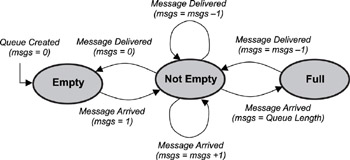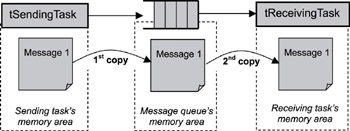Книга: Real-Time Concepts for Embedded Systems
7.3 Message Queue States
7.3 Message Queue States
As with other kernel objects, message queues follow the logic of a simple FSM, as shown in Figure 7.2 When a message queue is first created, the FSM is in the empty state. If a task attempts to receive messages from this message queue while the queue is empty, the task blocks and, if it chooses to, is held on the message queue's task-waiting list, in either a FIFO or priority-based order.

Figure 7.2: The state diagram for a message queue.
In this scenario, if another task sends a message to the message queue, the message is delivered directly to the blocked task. The blocked task is then removed from the task-waiting list and moved to either the ready or the running state. The message queue in this case remains empty because it has successfully delivered the message.
If another message is sent to the same message queue and no tasks are waiting in the message queue's task-waiting list, the message queue's state becomes not empty.
As additional messages arrive at the queue, the queue eventually fills up until it has exhausted its free space. At this point, the number of messages in the queue is equal to the queue's length, and the message queue's state becomes full. While a message queue is in this state, any task sending messages to it will not be successful unless some other task first requests a message from that queue, thus freeing a queue element.
In some kernel implementations when a task attempts to send a message to a full message queue, the sending function returns an error code to that task. Other kernel implementations allow such a task to block, moving the blocked task into the sending task-waiting list, which is separate from the receiving task-waiting list.

Figure 7.3: Message copying and memory use for sending and receiving messages.




